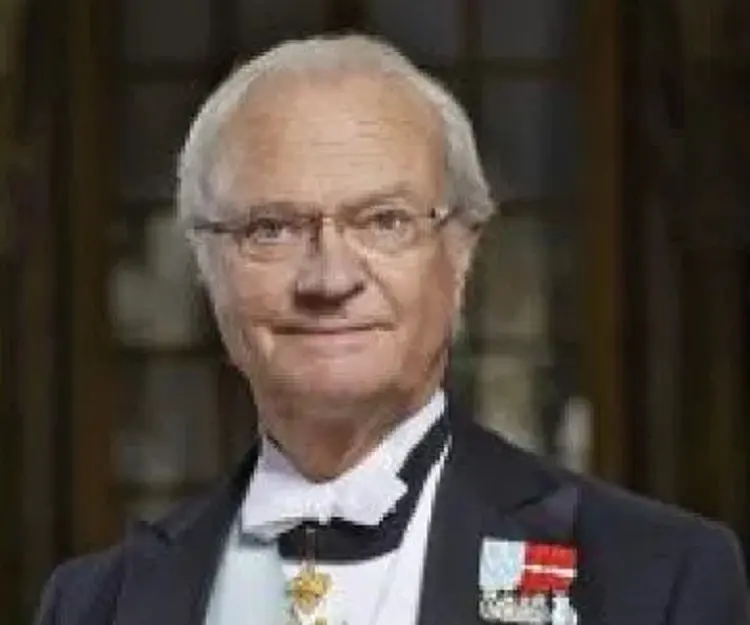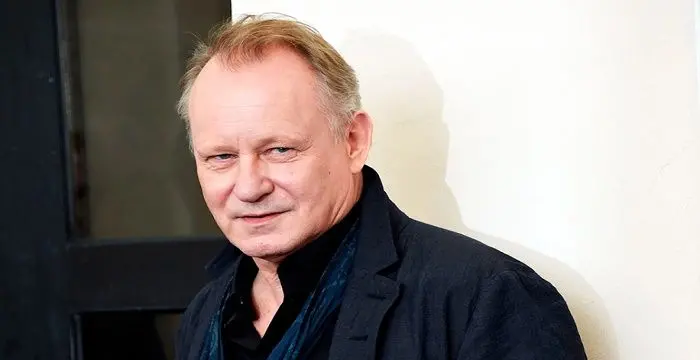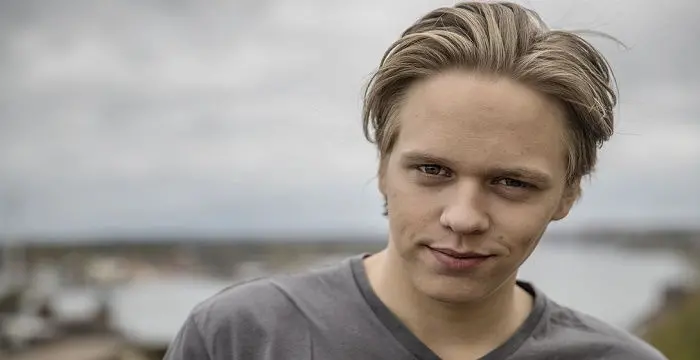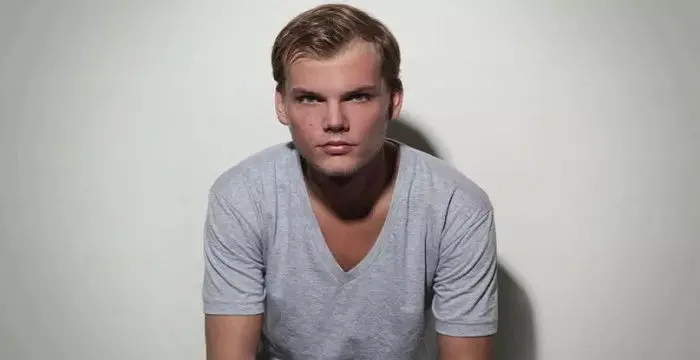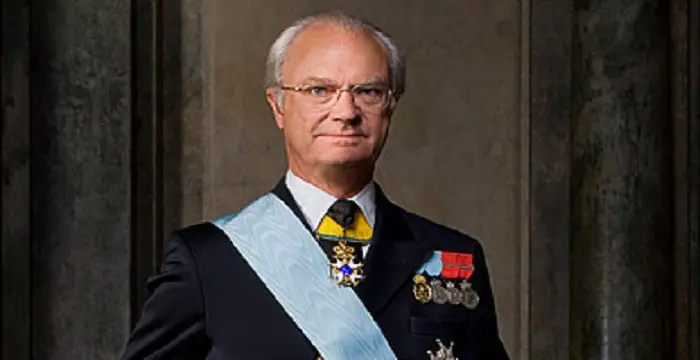
Carl XVI Gustaf of Sweden - Swedish Men, Family and Life
Carl XVI Gustaf of Sweden's Personal Details
Carl XVI Gustaf is the current King of Sweden
| Information | Detail |
|---|---|
| Birthday | April 30, 1946 |
| Nationality | Swedish |
| Famous | Historical Personalities, Emperors & Kings, Emperors, King of Sweden, Kings, Swedish Men |
| Spouses | Queen Silvia of Sweden (m. 1976) |
| Siblings | Baroness Silfverschiöld, Mrs. Ambler, Mrs. Magnuson, Princess Birgitta of Sweden, Princess Christina, Princess Désirée, Princess Margaretha |
| Known as | Carl Gustaf Folke Hubertus |
| Childrens | Crown Princess of Sweden, Prince Carl Philip, Princess Madeleine, Victoria |
| Birth Place | Haga Palace, Solna Municipality, Sweden |
| Gender | Male |
| Sun Sign | Taurus |
| Born in | Haga Palace, Solna Municipality, Sweden |
| Famous as | King of Sweden |
// Famous Kings
Sundiata Keita
Sundiata Keita was the founder of the Mali Empire in West Africa. This biography profiles his childhood, early life, struggles, founding of empire, rule, administration, achievements and also gives some fun facts.
Ashoka
Ashoka was the third emperor of the Mauryan Dynasty and ruled almost the entire Indian subcontinent. This biography profiles his childhood, life, reign, achievements and timeline
Murad IV
Murad IV was one of the mighty Sultans in the history of the Ottoman Empire. This biography profiles his childhood, family, accession, rule, administration and timeline.
Carl XVI Gustaf of Sweden's photo
Who is Carl XVI Gustaf of Sweden?
Carl Gustaf Folke Hubertus of the Royal House of Bernadotte or Carl XVI Gustaf is the current King of Sweden. He is the son of Prince Gustaf Adolf and grandson of King Gustaf VI Adolf. After losing his father in a plane crash when he was only nine months old, he was named as the second in line, after his grandfather, to his great-grandfather’s throne. In 1950, his grandfather became the king and he was named as the heir to the throne. He was groomed for his future responsibilities since childhood. He was taught history, sociology, political science, tax law, and economics at Uppsala University and Stockholm University. He also served in all three branches of the Swedish military, rising to the rank of captain in the army and air force and lieutenant in the navy. He was part of the Swedish Mission to the United Nations and Swedish International Development Cooperation Agency (SIDA). Later, he worked at the Swedish Embassy. At the age of 27, he ascended to the throne following the death of his grandfather. The new 1974 Instrument of Government was implemented a year later, formally reducing most of his legislative and military power and rendering the king to be the ceremonial head of the state. He has a keen interest in environment, technology, agriculture, trade, and industry. As the honorary president of the World Scout Foundation, he often participates in various scout activities.
// Famous Emperors
Sundiata Keita
Sundiata Keita was the founder of the Mali Empire in West Africa. This biography profiles his childhood, early life, struggles, founding of empire, rule, administration, achievements and also gives some fun facts.
Ashoka
Ashoka was the third emperor of the Mauryan Dynasty and ruled almost the entire Indian subcontinent. This biography profiles his childhood, life, reign, achievements and timeline
Murad IV
Murad IV was one of the mighty Sultans in the history of the Ottoman Empire. This biography profiles his childhood, family, accession, rule, administration and timeline.
Childhood & Early Life
Born on April 30, 1946, in Haga Palace in Solna, Stockholm County, Carl Gustaf is the only son of Prince Gustaf Adolf and Princess Sibylla. He has four older sisters, Princesses Margaretha, Birgitta, Désirée, and Christina.
On June 7, he was baptised by Erling Eidem, the Archbishop of Uppsala, at the Royal Chapel. His godparents were, among others, the Crown Prince and Crown Princess of Denmark (his paternal uncle and aunt), the Crown Prince and Crown Princess of Sweden (paternal grandparents), and the King of Sweden (his paternal great-grandfather).
On January 26, 1947, his father, Prince Gustaf Adolf, was coming back to Stockholm from a hunting trip and a visit to Prince Bernhard and Princess Juliana of the Netherlands when the KLM flight he was on got delayed and made a routine stop at Copenhagen before continuing to Stockholm.
The Douglas DC-3 aircraft took to the air and after climbing steadily to 50 meters, it stalled and plunged nose-first to the ground. All 16 passengers and six crew members on board, including the prince and his two companions, were killed. Young Carl did not learn about his father’s death until he was seven years of age. In a speech delivered in 2005, he spoke about his feelings about spending his early years without knowing his father.
The tragic accident made Carl the second in line to the throne after his grandfather, Gustaf VI Adolf. His great-grandfather, Gustaf V, died of complications from flu on October 29, 1950. Gustaf VI ascended to the throne and Prince Carl Gustaf was made the new crown prince of Sweden.
In 1946, he had already been created the Duke of Jämtland, and as the newly appointed heir to the throne in 1950, he received an achievement of arms with the arms of Jämtland in base. He would hold the title and the arms till his own ascension as the King of Sweden.
He began his academic life in the privacy of the Royal Palace in Stockholm, receiving the equivalent of the pre-school education. He then started attending Broms School in Stockholm, later enrolling at Sigtuna Boarding School in Sigtuna. He graduated in 1966.
Done with school, the Crown Prince began his two and a half years of training at the Royal Swedish Army, the Royal Swedish Navy, and the Royal Swedish Air Force. During this time, among other military activities, he was deployed on the mine-laying vessel Älvsnabben in the winter of 1966-67. He also finished a command course at the Swedish National Defence College. In 1968, he got his commission as a captain in the army and air force and as a lieutenant in the navy.
He returned to academic life to study history, sociology, political science, tax law, and economics at the University of Uppsala. He continued his study of economics at the University of Stockholm. He received a rigorous education in a broad range of subjects, including the Swedish judicial system, social welfare organisations and institutions, trade unions and employer associations. He learned about the workings of the Riksdag, the Government, and the Ministry of Foreign Affairs.
Besides serving at the Swedish Mission to the United Nations and in SIDA, he was also employed at a bank in London and at the Swedish Embassy in England. In France, he worked at the Swedish Chambers of Commerce and ‘Alfa Laval Company’ factory.
Accession & Reign
In 1973, King Gustaf VI Adolf passed away ten weeks shy of his 91st birthday. He was suffering from pneumonia, exacerbated by a severe decline in his health. On September 15, 1973 Crown Prince Carl Gustaf took the throne as the new Swedish King.
On September 19, the new king accepted the “Konungaförsäkran,” the obligation a king had to accept, during an extraordinary meeting of the cabinet where the king announced that he would be known as Carl XVI Gustaf and his title would be the “King of Sweden”. It broke a centuries old tradition as all the kings of Sweden before him had used the style “"By the Grace of God, King of the Swedes, the Goths/Geats and the Wends”.
Following that, he made appearances before various branches of the government and gave a speech in the Hall of State at the Stockholm Palace. He then came to the palace balcony to acknowledge the assembled crowd outside. As the king, he adopted the greater coat of arms of the Kingdom of Sweden as his own.
Since the Coup of 1809, which was orchestrated by a group of nobleman and was successful in dethroning King Gustav IV Adolf of Sweden, the ‘Instrument of Government’ had been implemented by the Riksdag of the Estates as one of the laws that made up the country’s constitution. It came into effect in place of the ‘Instrument of Government of 1772’, setting up a clear distinction between the powers allocated to the executive branch (the King) and to the legal branch (the Riksdag).
Over the next 160 years, the authority of Riksdag steadily increased and it made the problems of maintaining a government solely with the crown’s support quite apparent. In 1914, a constitutional conflict named the ‘Courtyard Crisis’ began between King Gustaf V and his Prime Minister Karl Staaff. It resulted in the foundation of the principles of the parliamentary democracy in 1917.
By the time Carl Gustaf became the king, a replacement for the 1809 law had already been drawn out. The new Instrument of Government law came into effect in 1974 and it took the last of the legislative and military powers away from the Crown.
While the King still is the highest ranking officer in all three services, being elevated to the positions of general and admiral following his ascension, he is not the commander-in-chief of the military any longer. Prior to the implementation of the law, the Crown formally appointed the Prime Minister; since 1974, that has become the prerogative of the Speaker of the Riksdag as the representative of the Riksdag.
The king primarily is the representative of Sweden and its people. As such, he makes state and official visits and welcomes foreign delegates to the nation, starts the annual session of the Riksdag, presides over the Special Council hosted during a change of Government and over the meetings of the Foreign Affairs Council. He accepts and signs ‘Letters of Credence’ of foreign diplomats to Sweden and of Sweden to foreign countries respectively.
During Carl XVI Gustaf’s reign, eight Prime Ministers have served under him, with three holding office for multiple terms. They are Olof Palme (Swedish Social Democratic Party; tenure: 1969-76, 1982-86), Thorbjörn Fälldin (Swedish Centre Party; 1976-78, 1979-82), Ola Ullsten (Liberal People’s Party; 1978-79), Ingvar Carlsson (Swedish Democratic Party; 1986-91, 1994-98), Carl Bildt (Moderate Party; 1991-94), Göran Persson (S; 1996-2006), Fredrik Reinfeldt (M; 2006-12), and the current Prime Minister of Sweden Stefan Löfven (S; 2014-present).
The king supports multiple organisations, such as the ‘Amref Health Africa’, the ‘Global Child Forum’, the ‘Allmänna Idrottsklubben’ (AIK), the ‘Friends of the Nationalmuseum’, andthe ‘Swedish Red Cross’.
Awards & Achievements
As the Swedish head of the state, the king holds the position of the Sovereign in the ‘Royal Order of the Seraphim’, the ‘Royal Order of the Sword’, the ‘Royal Order of the Polar Star’, the ‘Royal Order of Vasa’, and the ‘Royal Order of Charles XIII’. He is also the Grand Master of the ‘Order of the Saint John in Sweden’.
Foreign governments all over the world have conferred him with a significant number of prestigious honours. In 1982, he became the recipient of the ‘Bronze Wolf Award’ by the ‘World Scout Committee’.
He is the official presenter of the Nobel Prizes each year. The Japanese physicist Leo Esaki was the first Nobel Laureate to receive the award from him in 1973.
He has been awarded honorary doctoral degrees by the ‘Royal Institute of Technology’, the ‘Stockholm School of Economics’, the ‘Swedish University of Agricultural Sciences’, and the Finnish ‘Åbo Akademi University’.
Personal Life & Legacy
King Carl XVI Gustaf met Silvia Sommerlath at the 1972 Summer Olympics in Munich. Silvia, who was a non-royal Brazilian-German, had grown up in Brazil and Germany. They married four years later on June 19, 1976, at the Stockholm Cathedral. The ceremony was conducted by Olof Sundby, the Archbishop of Uppsala. In a Royal Variety Performance before the wedding, Swedish musical group ABBA performed their song ‘Dancing Queen’ for the first time’.
They have three children together, the Crown Princess Victoria (born 1977), Prince Carl Philip (1979), and Princess Madeleine (1982), and through them, five grandchildren. The family resided at the Stockholm Palace till 1980 before relocating to Drottningholm Palace.
Since his birth, Prince Carl Philip had been the heir apparent to the Swedish throne for seven months. On January 1, 1980, parliamentary changes were made to the Act of Succession, introducing absolute primogeniture. Princess Victoria, being the oldest child of the King, was formally designated as the Crown Princess and the heir to her father’s throne. Favouring the tradition, the king spoke out against the reform.
In 2010, following the publication of ‘Carl XVI Gustaf – The Reluctant Monarch’, an uncompromising book on his personal life, the royal family was rocked by the shocking allegations of infidelity and of hosting licentious parties levelled against the king. The book provoked a huge uproar in Sweden as it also alleged that the king visited strip clubs, let a friend pay a Serbian gangster to cover up his indiscretions, and downright lied to his people.
The book’s three authors, Thomas Sjöberg, Tove Meyer, and Deanne Rauscher, had reached out to several women who had been previously involved with the king and wrote that the queen knew about the affairs but was could not do anything about them. Despite the media whirlwind, however, the public perception about the royalty remained the same. As one of writers himself admitted, the Swedish people hold their royal family beyond reproach.
Only weeks after the book came out, there was a fresh accusation stating that the queen’s father, businessman Walther Sommerlath, was an active member of the Nazi party who, during Second World War, profited from running an armament factory taken away from Jewish owners. While the queen conceded that her father was a Nazi party member, she adamantly maintained that he was neither politically active nor a soldier.
Trivia
An automobile enthusiast, the King has multiple Porsche 911s, his favourite car model.
He does not vote in Swedish elections.
As the head of the Royal House, he holds the power of decision concerning titles and positions of relatives and family members.a
Carl XVI Gustaf of Sweden biography timelines
- // 1772 To 1809Since the Coup of 1809, which was orchestrated by a group of nobleman and was successful in dethroning King Gustav IV Adolf of Sweden, the ‘Instrument of Government’ had been implemented by the Riksdag of the Estates as one of the laws that made up the country’s constitution. It came into effect in place of the ‘Instrument of Government of 1772’, setting up a clear distinction between the powers allocated to the executive branch (the King) and to the legal branch (the Riksdag).
- // 1809 To 1974By the time Carl Gustaf became the king, a replacement for the 1809 law had already been drawn out. The new Instrument of Government law came into effect in 1974 and it took the last of the legislative and military powers away from the Crown.
- // 1914 To 1917Over the next 160 years, the authority of Riksdag steadily increased and it made the problems of maintaining a government solely with the crown’s support quite apparent. In 1914, a constitutional conflict named the ‘Courtyard Crisis’ began between King Gustaf V and his Prime Minister Karl Staaff. It resulted in the foundation of the principles of the parliamentary democracy in 1917.
- // 1946 To 1950In 1946, he had already been created the Duke of Jämtland, and as the newly appointed heir to the throne in 1950, he received an achievement of arms with the arms of Jämtland in base. He would hold the title and the arms till his own ascension as the King of Sweden.
- // 30th Apr 1946Born on April 30, 1946, in Haga Palace in Solna, Stockholm County, Carl Gustaf is the only son of Prince Gustaf Adolf and Princess Sibylla. He has four older sisters, Princesses Margaretha, Birgitta, Désirée, and Christina.
- // 26th Jan 1947On January 26, 1947, his father, Prince Gustaf Adolf, was coming back to Stockholm from a hunting trip and a visit to Prince Bernhard and Princess Juliana of the Netherlands when the KLM flight he was on got delayed and made a routine stop at Copenhagen before continuing to Stockholm.
- // 29th Oct 1950The tragic accident made Carl the second in line to the throne after his grandfather, Gustaf VI Adolf. His great-grandfather, Gustaf V, died of complications from flu on October 29, 1950. Gustaf VI ascended to the throne and Prince Carl Gustaf was made the new crown prince of Sweden.
- // 1966He began his academic life in the privacy of the Royal Palace in Stockholm, receiving the equivalent of the pre-school education. He then started attending Broms School in Stockholm, later enrolling at Sigtuna Boarding School in Sigtuna. He graduated in 1966.
- // 1966 To 1968Done with school, the Crown Prince began his two and a half years of training at the Royal Swedish Army, the Royal Swedish Navy, and the Royal Swedish Air Force. During this time, among other military activities, he was deployed on the mine-laying vessel Älvsnabben in the winter of 1966-67. He also finished a command course at the Swedish National Defence College. In 1968, he got his commission as a captain in the army and air force and as a lieutenant in the navy.
- // 1972 To 19th Jun 1976King Carl XVI Gustaf met Silvia Sommerlath at the 1972 Summer Olympics in Munich. Silvia, who was a non-royal Brazilian-German, had grown up in Brazil and Germany. They married four years later on June 19, 1976, at the Stockholm Cathedral. The ceremony was conducted by Olof Sundby, the Archbishop of Uppsala. In a Royal Variety Performance before the wedding, Swedish musical group ABBA performed their song ‘Dancing Queen’ for the first time’.
- // 1973He is the official presenter of the Nobel Prizes each year. The Japanese physicist Leo Esaki was the first Nobel Laureate to receive the award from him in 1973.
- // 15th Sep 1973In 1973, King Gustaf VI Adolf passed away ten weeks shy of his 91st birthday. He was suffering from pneumonia, exacerbated by a severe decline in his health. On September 15, 1973 Crown Prince Carl Gustaf took the throne as the new Swedish King.
- // 1974While the King still is the highest ranking officer in all three services, being elevated to the positions of general and admiral following his ascension, he is not the commander-in-chief of the military any longer. Prior to the implementation of the law, the Crown formally appointed the Prime Minister; since 1974, that has become the prerogative of the Speaker of the Riksdag as the representative of the Riksdag.
- // 1st Jan 1980Since his birth, Prince Carl Philip had been the heir apparent to the Swedish throne for seven months. On January 1, 1980, parliamentary changes were made to the Act of Succession, introducing absolute primogeniture. Princess Victoria, being the oldest child of the King, was formally designated as the Crown Princess and the heir to her father’s throne. Favouring the tradition, the king spoke out against the reform.
- // 1982Foreign governments all over the world have conferred him with a significant number of prestigious honours. In 1982, he became the recipient of the ‘Bronze Wolf Award’ by the ‘World Scout Committee’.
- // 2005The Douglas DC-3 aircraft took to the air and after climbing steadily to 50 meters, it stalled and plunged nose-first to the ground. All 16 passengers and six crew members on board, including the prince and his two companions, were killed. Young Carl did not learn about his father’s death until he was seven years of age. In a speech delivered in 2005, he spoke about his feelings about spending his early years without knowing his father.
- // 2010In 2010, following the publication of ‘Carl XVI Gustaf – The Reluctant Monarch’, an uncompromising book on his personal life, the royal family was rocked by the shocking allegations of infidelity and of hosting licentious parties levelled against the king. The book provoked a huge uproar in Sweden as it also alleged that the king visited strip clubs, let a friend pay a Serbian gangster to cover up his indiscretions, and downright lied to his people.
// Famous Swedish Men
Bertil Gotthard Ohlin
Bertil Gotthard Ohlin was a famous Swedish economist. This biography profiles his childhood, family life & achievements.
Joel Kinnaman
Joel Kinnaman is an actor best known for appearing in the Swedish film ‘Easy Money.’ Check out this biography to know about his birthday, childhood, family life, achievements, and fun facts about him.
Stellan Skarsgård
Stellan Skarsgard is a Swedish actor known for his role in the flick ‘Breaking the Waves.’ Check out this biography to know about his birthday, childhood, family life, achievements and fun facts about him.
Valter Skarsgård
Valter Skarsgård is the youngest son of famous Swedish actors, Stellan Skarsgård and My Skarsgård. Let’s have a look at his family, personal life, career, age, birthday, etc.
Avicii
Tim Bergling, better known by his stage name Avicii, was a Swedish musician, DJ, remix artist, and record producer. Check out this biography to know more about his childhood, family, personal life, death, etc.
Jwan Yosef
Jwan Yosef is a Syrian-born Swedish artist and painter. Check out this biography to know about his childhood, family, personal life, career, relationships, etc.
Carl XVI Gustaf of Sweden's FAQ
What is Carl XVI Gustaf of Sweden birthday?
Carl XVI Gustaf of Sweden was born at 1946-04-30
Where is Carl XVI Gustaf of Sweden's birth place?
Carl XVI Gustaf of Sweden was born in Haga Palace, Solna Municipality, Sweden
What is Carl XVI Gustaf of Sweden nationalities?
Carl XVI Gustaf of Sweden's nationalities is Swedish
Who is Carl XVI Gustaf of Sweden spouses?
Carl XVI Gustaf of Sweden's spouses is Queen Silvia of Sweden (m. 1976)
Who is Carl XVI Gustaf of Sweden siblings?
Carl XVI Gustaf of Sweden's siblings is Baroness Silfverschiöld, Mrs. Ambler, Mrs. Magnuson, Princess Birgitta of Sweden, Princess Christina, Princess Désirée, Princess Margaretha
Who is Carl XVI Gustaf of Sweden childrens?
Carl XVI Gustaf of Sweden's childrens is Crown Princess of Sweden, Prince Carl Philip, Princess Madeleine, Victoria
What is Carl XVI Gustaf of Sweden's sun sign?
Carl XVI Gustaf of Sweden is Taurus
How famous is Carl XVI Gustaf of Sweden?
Carl XVI Gustaf of Sweden is famouse as King of Sweden




